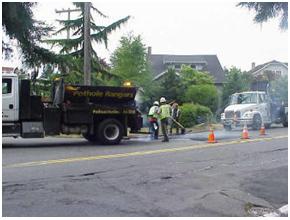In this issue of the RoadReady newsletter we’ll help you evaluate the answer to that question and share the key pieces of an effective Stormwater Prevention and Preparedness Plan (SWPPP, for short).
With many of the world’s leaders meeting in Copenhagen this week, the world’s attention is on environmental issues. As we found out a few months ago at the NAPA Young Leaders conference, the Obama Administration’s legislative priorities are as follows:
- Health care reform
- The environment
- Highway reauthorization
Obviously, we are most interested in that 3rd priority, but let’s not overlook the emphasis that is being placed on issues regarding the environment.
Make sure that you’ve covered your environmental bases
Having an informed and aware group of employees is your best insurance against regulatory fines or potential environmental problems. In our industry, environmental regulations are extremely important and it’s crucial that you and your crews are always in compliance. At Pavia Systems, our customers often work with us on solutions to their regulatory training needs. Increasingly, we are hearing that employees aren’t considered “RoadReady”® until they’re properly trained on environmental regulations. You’re running a substantial risk if your people aren’t familiar with the requirements.
In fact, some environmental permits are requiring that you have a training program
The NPDES (National Pollution Discharge Elimination System) permit was recently revised, placing a much larger emphasis on training as a required permit application component. Compliance with environmental regulations requires employers to focus on employee education and training. Pavia is the leading online training provider for the roadbuilding industry and we are constantly working to make education and training easier.
In that spirit, we’d like to share some basics around a key component of any company’s environmental planning:
Your Stormwater Prevention and Preparedness Plan (SWPPP)
- Implement best management practices that identify, reduce, eliminate or prevent the discharge of stormwater pollutants.
- Prevent violations of water quality.
- Control stormwater flow rates.
- Eliminate discharges of unpermitted process water to stormwater drainage systems.
Specifically, let’s discuss the activities that compliant organizations engage in. At a minimum, companies that take their SWPPP seriously are committed to the following actions:
- They take an inventory of materials. In particular, they focus on the materials that could impact stormwater.
- They identify and document all plant activities whenever a production plant is involved.
- They establish best management practices with respect to maintenance, training and inspection procedures, and then they follow them.
- They select employees to be a part of a pollution prevention team and ensure that those team members are all trained on an annual basis, at a minimum.
As highlighted by the recent NPDES change, it is increasingly important to rely on your team in order to address environmental issues. Establishing a team of people who are familiar with the regulations creates an environment that fosters mutual responsibility in the observation of environmental best practices. Organizations that value training and teamwork are embracing this philosophy and investing in their people, every day.
You don’t have to manage the training all by yourself
With regulations changing as often as they do, we understand that it’s challenging to ensure that your people have the most up-to-date information. You need a partner in that effort.
Companies like LaFarge are utilizing our online training (read about how, here) in order to achieve regulatory compliance without the headaches. In particular, our Stormwater Pollution Prevention Awareness course (see our course catalog) is proving to be popular as an environmental education tool.
Up-to-date and reviewed by experts from the industry, this course has our customers more comfortable with their training program than ever before. When your people are all part of your environmental team, you can rest easier, knowing that your company’s environmental compliance is in good hands.
We hope that you are more informed about the elements of a good SWPPP after reading this issue of our newsletter.

